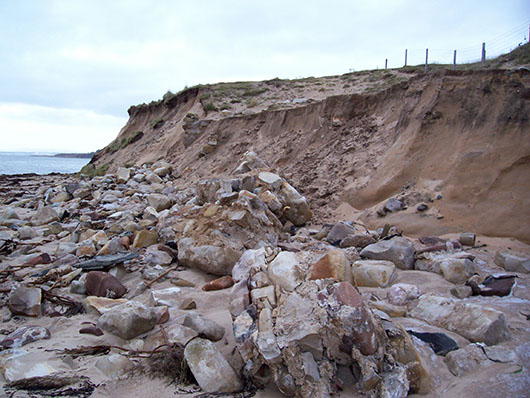Saving Scotland’s treasure chest

The recent storms that have battered the coastlines of Scotland could reveal important new archaeological sites, say experts at the University of St Andrews.
Working as part of a national project, St Andrews’ archaeologists are appealing to the public for help in saving valuable information about Scotland’s history. The drive follows the east and west coasts of Scotland being badly damaged by wind and rain over the last two weeks, threatening hundreds of archaeological sites.
A few of the most famous sites in Scotland are shielded behind by sea walls, but the vast majority are unprotected and vulnerable to damage.
Researcher Tom Dawson said, “Scotland’s coast is a treasure chest of information about the past, and some of Europe’s best-preserved ancient sites were found buried in Scottish sand dunes. The sand has preserved sites for centuries, but recent storms have washed away parts of the coast edge, making this irreplaceable archive incredibly vulnerable.”
Even a small amount of erosion can cause a great deal of damage and last year, four hundred year-old salt pans, Brora’s first building, were destroyed in a storm in East Sutherland.
Scottish charity, SCAPE, fears that many more sites may have been damaged after the recent storms, and is asking for help in recording what has survived and what has been lost. Working with Historic Scotland and the University of St Andrews, their latest venture, the Scotland’s Coastal Heritage at Risk Project (SCHARP) shows all sites found in recent surveys.
They are appealing for people to visit local sites and tell the project team if the sites have been damaged. Information can be sent back via the website www.scharp.co.uk or directly through an android or iphone app. They are also asking for photos of sites and of stretches of beach affected during the storms.
The team say that new sites, buried deep within the sand, could be uncovered thanks to the storms. Tom Dawson explained, “The recent storms have been particularly violent, and last week, the spring tides mean that the sea was very high. There are already reports of changes to the coast, and in some cases, erosion has revealed new sites that we didn’t know about.
“Some of Scotland’s most famous sites were revealed after storms, and we want to know if another Skara Brae has been uncovered. The help of the public will help us to save Scotland’s precious heritage.”
SCAPE has been running community projects all around the Scottish coast for over a decade, including a number of archaeological digs, such as at Brora. Joanna Hambly, a project officer with SCAPE said, “It’s always sad when a site gets destroyed, but at Brora, local people told us about the site and we worked with the local community to record the building before the storm damaged it. We can’t protect everything, but what we can do is work at the most vulnerable sites, saving artefacts and recording buildings before they are lost.”
ENDS
Note to Editors
For more information and images contact Tom Dawson on [email protected], tel: 07807201544 or 01334 467172.
SCAPE is a registered charity that works to promote the heritage of Scotland’s coast, especially sites threatened by erosion.
The Scotland’s Coastal Heritage at Risk Project (SCHARP) is a three-year project funded by the Heritage Lottery Fund, Historic Scotland, the Crown Estate and the University of St Andrews.
The project is updating information on eroding sites; and then doing more detailed community projects at twelve sites.
The SCHARP Sites at Risk map displays over 12,000 sites, with approximately 1,000 sites listed as being a priority for monitoring and other work.
Issued by the Press Office
Contact Gayle Cook, Senior Communications Manager on Tel: 01334 467227, mobile: 07900 050 103 or email: [email protected]
Ref: Scotland’s Treasure Chest 171213
Category Research